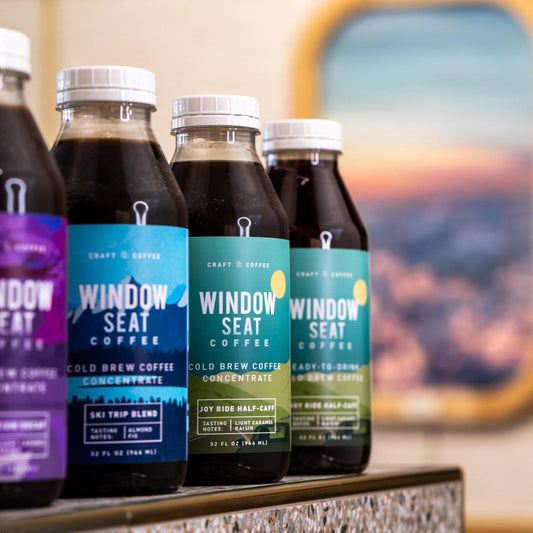
How to Make Decaf Cold Brew at Home
Kristen BoydShare

How to Make Decaf Cold Brew at Home: A Complete Guide
Welcome to the Window Seat Coffee blog! Whether you're a seasoned coffee enthusiast or just beginning your coffee journey, we're thrilled to have you here. Today, we're delving into a topic that's often overlooked but highly requested—how to make decaf cold brew at home. Decaf coffee lovers, this one's for you!
Can you Cold Brew Decaf Coffee?

Of course you can! And if you want the quick answer how, you do it the same way as caffeinated coffee. And if you’re feeling lazy (no judgement here!), check out our decaf cold brew concentrate here!
Now, before we get into the nitty-gritty of brewing, let's talk about why decaf cold brew is a fantastic option. Cold brew coffee is known for its smooth, less acidic taste compared to hot-brewed coffee. It's perfect for those hot summer days when you need a refreshing pick-me-up without the jolt of caffeine. Decaf cold brew offers all the rich flavors and benefits of regular cold brew, minus the caffeine. It's ideal for those who are sensitive to caffeine, want to enjoy a cup later in the day, or are looking to cut down on their caffeine intake.
Also, a word of caution: all decaf coffee does contain some caffeine. So, if you’re allergic to caffeine, it’s best to stay away from all coffee, even decaf.
What You’ll Need to Cold Brew Decaf at Home
Making decaf cold brew at home can be easier than you might think. Here’s a basic list of what you’ll need:
- Decaf Coffee Beans: Start with high-quality decaf coffee beans. We recommend the Staycation blend, which are decaffeinated with a water process and always ship freshly roasted.
- Grinder: A burr grinder is ideal for achieving a coarse grind, which is crucial for cold brew.
- Water: Use filtered water for the best taste. Curious how “hard” or “soft” your water is? Check out this gauge.
- A Large Pitcher: Any cup, jar, or pitcher that holds a lot of water will work!
- Coffee Filter or Cheesecloth: For straining the coffee grounds.
There are also dedicated cold brew makers that do make your life easier if you plan on cold brewing often. For a great value, we love the Toddy® Cold Brew maker. For a real investment piece, check out the Brew Bomb™ ACE Brewer!
Step-by-Step Guide to Making Decaf Cold Brew

Step 1: Grind Your Beans
For cold brew, you'll want a coarse grind. If your grind is too fine, it can result in over-extraction, a bitter taste, and very low output. Aim for a texture similar to coarse sea salt. For reference, our grinder has a scale of 0-16 and we use a 14 for cold brew.
Step 2: Measure Your Ingredients
We recommend making a concentrate, as it will take up less space and can be adjusted more easily to taste. For our concentrate, we like to use a ratio of 1:8 coffee to water. If you grind an entire 12oz bag, this means measuring out 96 ounces (or 3 quarts) of water.
Step 3: Combine Your Ingredients
Place the ground coffee in your cold brew maker or vessel of choice. Slowly add the cold water, making sure all the grounds are saturated. Stir gently to ensure even extraction.
Step 4: Steep
Cover your container and let it steep at room temperature or in the refrigerator. The colder the temperature, the slower the extraction process will take. The steeping time can vary, but a good starting point is 12-24 hours. The longer it steeps, the higher extraction you will achieve. We recommend steeping at room temperature for 18 hours, but have fun experimenting!
Step 5: Strain Your Coffee
Once your cold brew has steeped to your liking, it’s time to strain out the grounds. If you’re using a cold brew maker, this step is usually straightforward as most come with built-in filters. If you’re using a bucket or jar, you’ll need to strain the coffee through a coffee filter or cheesecloth into another container.

Step 6: Serve and Enjoy
Your decaf cold brew is now ready to enjoy! Serve it over ice and customize it to your taste. You can add milk, cream, a splash of vanilla extract, or sweeten it with your favorite syrup. The possibilities are endless.
Troubleshooting Common Issues
Bitter Taste
- Over-Extraction: If your cold brew tastes bitter, it might be over-extracted. Try reducing the steeping time or using a coarser grind. (Obsessed with all things extraction? Take your cold brew to the next level with a coffee refractometer to help you calculate your extraction percentage!)
- Water Quality: Ensure you’re using filtered water. Tap water can sometimes introduce unwanted flavors.
Weak Flavor
- Under-Extraction: If your cold brew is too weak, it might be under-extracted. Increase the steeping time or use a finer grind.
- Coffee to Water Ratio: Add coffee or reduce water to make a stronger brew.
Cloudy Appearance
- Improper Straining: Ensure you’re using a fine coffee filter or cheesecloth to strain the coffee. Any remaining fine particles can make your cold brew cloudy. It won't affect the taste of the cold brew, but may produce an unappealing mouthfeel. If necessary, strain twice!
Conclusion
Making decaf cold brew at home is a simple and rewarding process. With a few basic tools and high-quality decaf coffee beans from Window Seat Coffee, you can enjoy a smooth, refreshing cup of cold brew any time of day. Whether you prefer it black, with a splash of milk, or in a creative recipe, decaf cold brew is a versatile and delicious option.
We hope this guide has inspired you to try making your own decaf cold brew at home. If you have any questions or want to share your cold brew creations, please let us know. Happy brewing!



